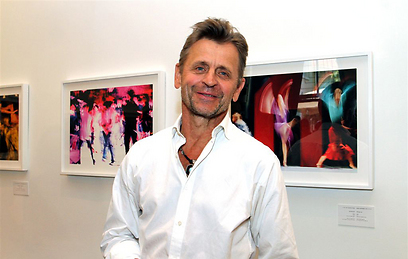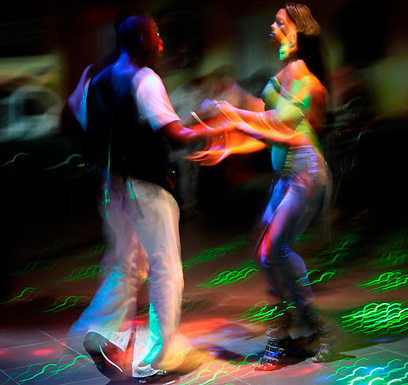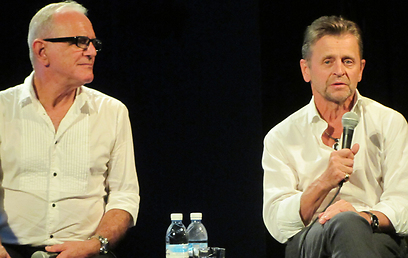
An exhibition of photographs by legendary Russian dancer Mikhail Baryshnikov, which opened Tuesday at the Suzanne Dallal Center in Tel Aviv, makes still images dance.

Batsheva dancers (Photo: Mikhail Baryshnikov)
The body of the dancers he photographed in the past 10 years turns into brush strokes thanks to the slow exposure.
"I watch the movement from the point of view of a painter," he says. "It's the angle of light that falls on the dancers, it's the blurry parts of the body, that turn in the darkroom into an abstract painting. It's a magical moment."
This is Baryshnikov's fourth time in Israel. His previous visits included an intimate performance with dancer Ana Laguna and a theater production staged by Dmitry Krymov. This time he arrived as a photographer and philanthropist.
Baryshnikov's signed dance photos will be sold to the highest bidder as the exhibition closes Saturday, and proceeds will help support young Israeli dancers.

Baryshnikov opens exhibition in Tel Aviv (Photo: Ofer Amram)
"Knowing that my pictures will help create new dances and encourage young artists makes me very happy," he says. "I was very impressed by the vitality of the Israeli dance, by that 'chutzpa', in a good sense, which one cannot miss in Israeli choreography.
"And there is of course the driving force, Ohad Naharin's Batsheva Dance Company, and the unusual group of dancers gathered around him. The amount of talent he attracts is amazing. It's fascinating watching this group of dancers who arrived in Israel from all over the world thanks to him."
His affair with the art of photography began about a decade ago. A friend of his, a photographer, pleaded with him to take a small Nikon camera on his world tours. Baryshnikov agreed. When he returned home from one of his trips with 20 black and white rolls of camera film, he realized that he had become addicted.
"I hadn't held a camera in my hands since I was a kid. In fact, when I was 10 I got a camera as a gift but never took this whole thing seriously. But suddenly something happened. The moment when you are alone with the camera film in the darkroom is near magic."

Nightclub in Dominican Republic (Photo: Mikhail Baryshnikov)
He takes pictures in order to remind himself of moments, to understand the meaning of dancing. Through the camera he tries to interpret the magic of movement.
"I haven't reached the technical level of great photographers. Gadi Dagon, for example, also photographs movement in a similar manner and there is no doubt that he is much better than me. I'm not as experienced, I'm in the middle of the road, but I know there's something there.
"These are my photos and they remind me of moments, people, places. They surprise me, evoke emotions in me, make me fall in love with dancing all over again."
Photographing movement is like a child's play. "I try to predict the next movement and capture it at the right moment," he says. "Dancing is a live experience which changes at any given moment. In order to photograph a dance you must be attentive, keep the rhythm, be alert in order to capture the moment and not to let it get away."

With Suzanne Dallal Center Director Yair Vardi (Photo: Merav Yudilovitch)
In the beginning, Baryshnikov didn't even think about photographing dance. "I have been photographed so much throughout the years, on stage and in the rehearsal room, and in most cases I hated the result. I always thought photography does not do justice to the art of dance because it freezes the moment, suffocates the movement."
On one of his trips to his summer house in the Dominican Republic, something changed. He went out on the street with a simple digital camera and took pictures: Children running, young people dancing in a nightclub, a commotion on the street.
"I photographed the movement for hours on end and uploaded all the material to my computer. I suddenly felt that it was possible to photograph dancing without damaging its essence, without freezing the movement."
In his photos he searches for decorative aesthetic values, but also for values of movement connecting to the act of dancing and to the chorographer's point of view on movement.
"Merce Cunningham let me be a fly on the wall of the dance company's rehearsal room. I accompanied them for two years in the rehearsal room, on their tour and at premieres. We later selected images which were included in the book 'Merce My Way.'
"It was a fascinating process. Merce said that through the pictures, through the dynamics of the movement reflected from them, he reinterpreted his work."
Although many years have passed since he began documenting dancing, Baryshnikov still wonders about its charm.
"I have always asked myself why do people actually like dancing. It's a major question, and it does not necessarily have to do with techniques or beauty, but with this magnificent moment each artist lives for. There is a secret to dancing. Dancing has that same 'je ne sais quoi', which cannot be explained or defined. That is exactly what I am trying to capture with my camera."















